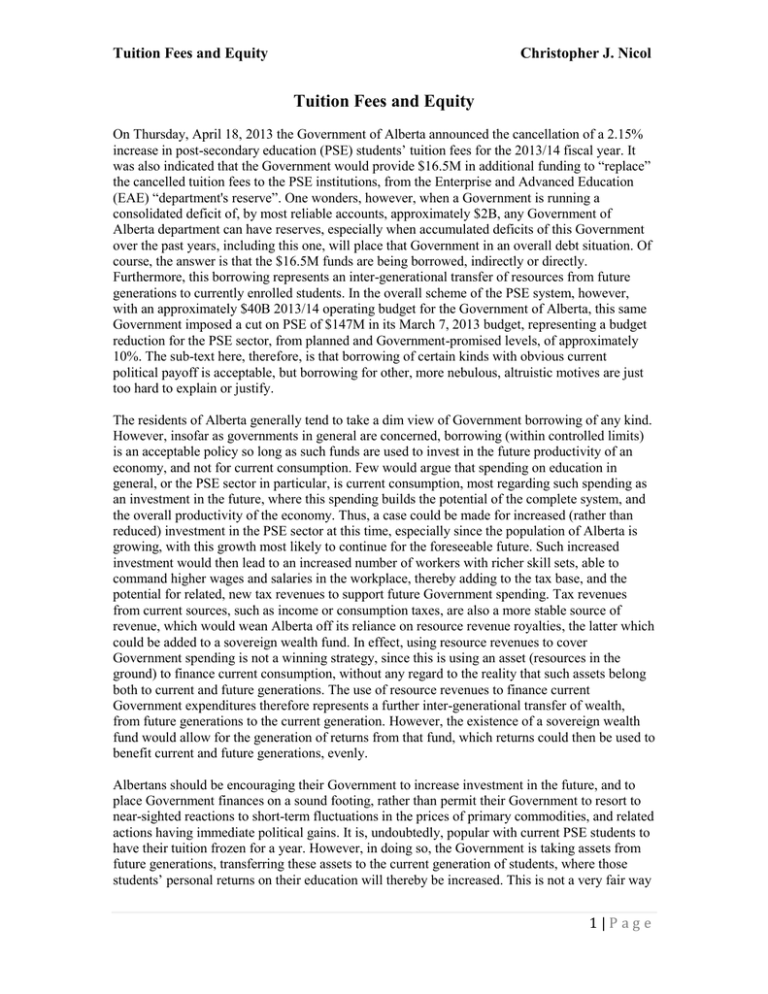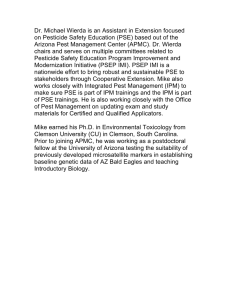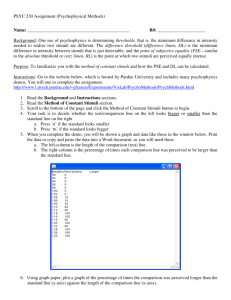Document 13386576
advertisement

Tuition Fees and Equity Christopher J. Nicol Tuition Fees and Equity On Thursday, April 18, 2013 the Government of Alberta announced the cancellation of a 2.15% increase in post-secondary education (PSE) students’ tuition fees for the 2013/14 fiscal year. It was also indicated that the Government would provide $16.5M in additional funding to “replace” the cancelled tuition fees to the PSE institutions, from the Enterprise and Advanced Education (EAE) “department's reserve”. One wonders, however, when a Government is running a consolidated deficit of, by most reliable accounts, approximately $2B, any Government of Alberta department can have reserves, especially when accumulated deficits of this Government over the past years, including this one, will place that Government in an overall debt situation. Of course, the answer is that the $16.5M funds are being borrowed, indirectly or directly. Furthermore, this borrowing represents an inter-generational transfer of resources from future generations to currently enrolled students. In the overall scheme of the PSE system, however, with an approximately $40B 2013/14 operating budget for the Government of Alberta, this same Government imposed a cut on PSE of $147M in its March 7, 2013 budget, representing a budget reduction for the PSE sector, from planned and Government-promised levels, of approximately 10%. The sub-text here, therefore, is that borrowing of certain kinds with obvious current political payoff is acceptable, but borrowing for other, more nebulous, altruistic motives are just too hard to explain or justify. The residents of Alberta generally tend to take a dim view of Government borrowing of any kind. However, insofar as governments in general are concerned, borrowing (within controlled limits) is an acceptable policy so long as such funds are used to invest in the future productivity of an economy, and not for current consumption. Few would argue that spending on education in general, or the PSE sector in particular, is current consumption, most regarding such spending as an investment in the future, where this spending builds the potential of the complete system, and the overall productivity of the economy. Thus, a case could be made for increased (rather than reduced) investment in the PSE sector at this time, especially since the population of Alberta is growing, with this growth most likely to continue for the foreseeable future. Such increased investment would then lead to an increased number of workers with richer skill sets, able to command higher wages and salaries in the workplace, thereby adding to the tax base, and the potential for related, new tax revenues to support future Government spending. Tax revenues from current sources, such as income or consumption taxes, are also a more stable source of revenue, which would wean Alberta off its reliance on resource revenue royalties, the latter which could be added to a sovereign wealth fund. In effect, using resource revenues to cover Government spending is not a winning strategy, since this is using an asset (resources in the ground) to finance current consumption, without any regard to the reality that such assets belong both to current and future generations. The use of resource revenues to finance current Government expenditures therefore represents a further inter-generational transfer of wealth, from future generations to the current generation. However, the existence of a sovereign wealth fund would allow for the generation of returns from that fund, which returns could then be used to benefit current and future generations, evenly. Albertans should be encouraging their Government to increase investment in the future, and to place Government finances on a sound footing, rather than permit their Government to resort to near-sighted reactions to short-term fluctuations in the prices of primary commodities, and related actions having immediate political gains. It is, undoubtedly, popular with current PSE students to have their tuition frozen for a year. However, in doing so, the Government is taking assets from future generations, transferring these assets to the current generation of students, where those students’ personal returns on their education will thereby be increased. This is not a very fair way 1|Page Tuition Fees and Equity Christopher J. Nicol of inter-generational accounting, but it fits the expedience of the electoral cycle, and the cycle of student governance bodies within PSE institutions. Far better, however, if borrowing is to take place to support PSE institutions, that the borrowing benefit the whole system, and thus all generations and all Albertans, rather than to simply give an increased subsidy to existing students within the system. That is, approximately 25% of the cost of running Alberta PSE institutions comes from current students through their payment of tuition fees. Thus, a subsidy of 75% is already accruing to these students, so any additional funds available to invest in the system (even if “only” $16.5M) should be a system-specific investment, rather than a generation-specific one. Dr. Christopher J. Nicol, Professor of Economics, University of Lethbridge, April 21, 2013. 2|Page




